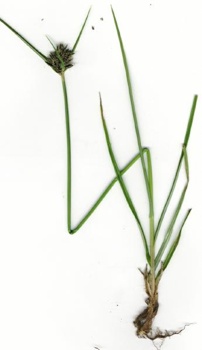Weeds
Cyperus rotundus L. - Cyperus Round
Systematic position.
Family Cyperaceae, genus Cyperus L.Biological group.
Rhizome perennial plant.Morphology and biology.
Underground shoots carry numerous tuberose thickenings helping plants to breed. Stems 7-35 (50) cm high, usually single, with basal leaves, triquetrous, glabrous. Leaves linear, glabrous, 2.5 mm wide, usually with short vaginas, aggregated at base of stem. Inflorescence is umbel-shaped, with unequal rays of 0.3-10 cm in length bearing apical friable bunches of spikes; the spikes oblong-linear, 10-20 mm in length and 1-2 mm in width; 2-3 basal leaves considerably exceed inflorescence in length. Style with stigmas 6-7 mm in length. Nutlet triquetrous, grayish-brown, about 1.5 mm in length. The seeds have long period of germination (since April till September) and very low germinating capacity (fresh-mature seeds to 6-7%). After winter the germinating capacity increase to 50-80%. The seeds germinate in lower places under sufficient moisture. Viability of seeds is to 10 years. Seedlings develop slowly in first 20-30 days of life and may be easily abolished by cultivators. First fruits form in the beginning of June. Tubers penetrate into soil to 80-100 cm deep (but they are mostly located at a depth to 20 cm). Over-ground shoots develop only from young tubers located in soil at a depth to 5-6 cm. One plant is able to form about 10 000 seeds and to 100 tubers during a vegetation period. V (VI)-VII (X).Distribution.
South of Ukraine, the Caucasus, Middle Asia (except northern districts). Outside the former USSR territories: Atlantic Europe, western and eastern Mediterranean, Balkan Peninsula, Minor and Central Asia, tropical Arabia, Africa, North and Southern America, Australia.Ecology.
The heat-loving, heat-resisting, rather hygrophilous plant. North boundary of its distribution is limited by low temperatures of the winter period and by depth of soil freezing, reaching to 43 and 44°N. Over-ground parts dye away after the first autumn frosts; young underground shoots suffer from late spring frosts. The plant populates sandy places, humid rivers bank, cotton and rice fields. In natural conditions it develops on loamy and damp solonetzic soils, especially on alluvial "cultural" layer of irrigated crops. It develops better on friable, well aerated sandy and argillaceous unsalted soils; it is depressed on heavy and salted soils. Light-loving plant: in light places by comparison with shady ones it forms over-ground shoots 6 times larger, and the number and length of rhizomes increase by 1.5 times. It is introduced in newly developed territories with watering mainly, in the lesser degree with manure, bird excrements, by wind and wheels of agricultural instruments and transport.Economic significance.
It is the most significant weed of 18 most malicious weed plant species of subtropical and tropical farming in both hemispheres. It is a weed of irrigated agriculture (cotton, maize, vegetable cultures, rice, sugar-cane, rarely lucerne and grain cultures), of gardens, kitchen-gardens, plantations of subtropical cultures. Control measures: deep and timely autumn plowing to a depth of 25-30 cm; deep and frequent interrow treatments of the ground before closing of plants; sowing of lucerne in autumn and its good cultivation for ousting the Round Cyperus form fields; dense sowing of grain and high-strapping fodder crops on weedy fields.Related references.
Komarov V.L., ed. 1935. Flora of the USSR, v. 3. Moscow & Leningrad: AN SSSR. 636 p. (in Russian).Nikitin, V.V. 1983. Weed plants of the USSR flora. Leningrad: Nauka. 454 p. (in Russian).
Ulyanova T.N. 1998. Weeds in the flora of Russia and other CIS states. St. Petersburg: VIR. 233 p. (in Russian).
Volkov, A.N., ed. 1935. The regions of the distribution of the main weeds in the USSR. Moscow; Leningrad: Publishing House of Kolkhoz & Sovkhoz Literature. 153 p. (in Russian).


